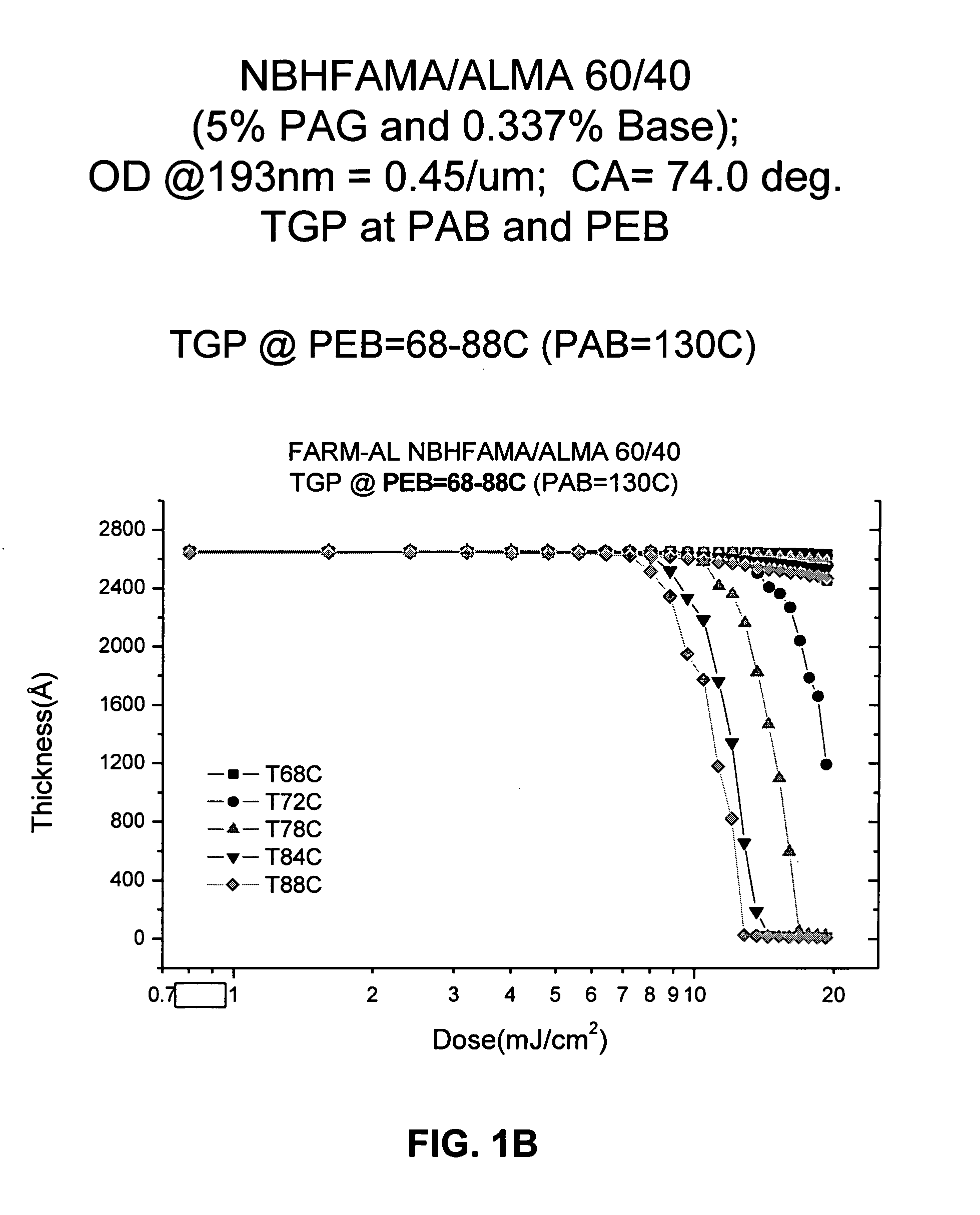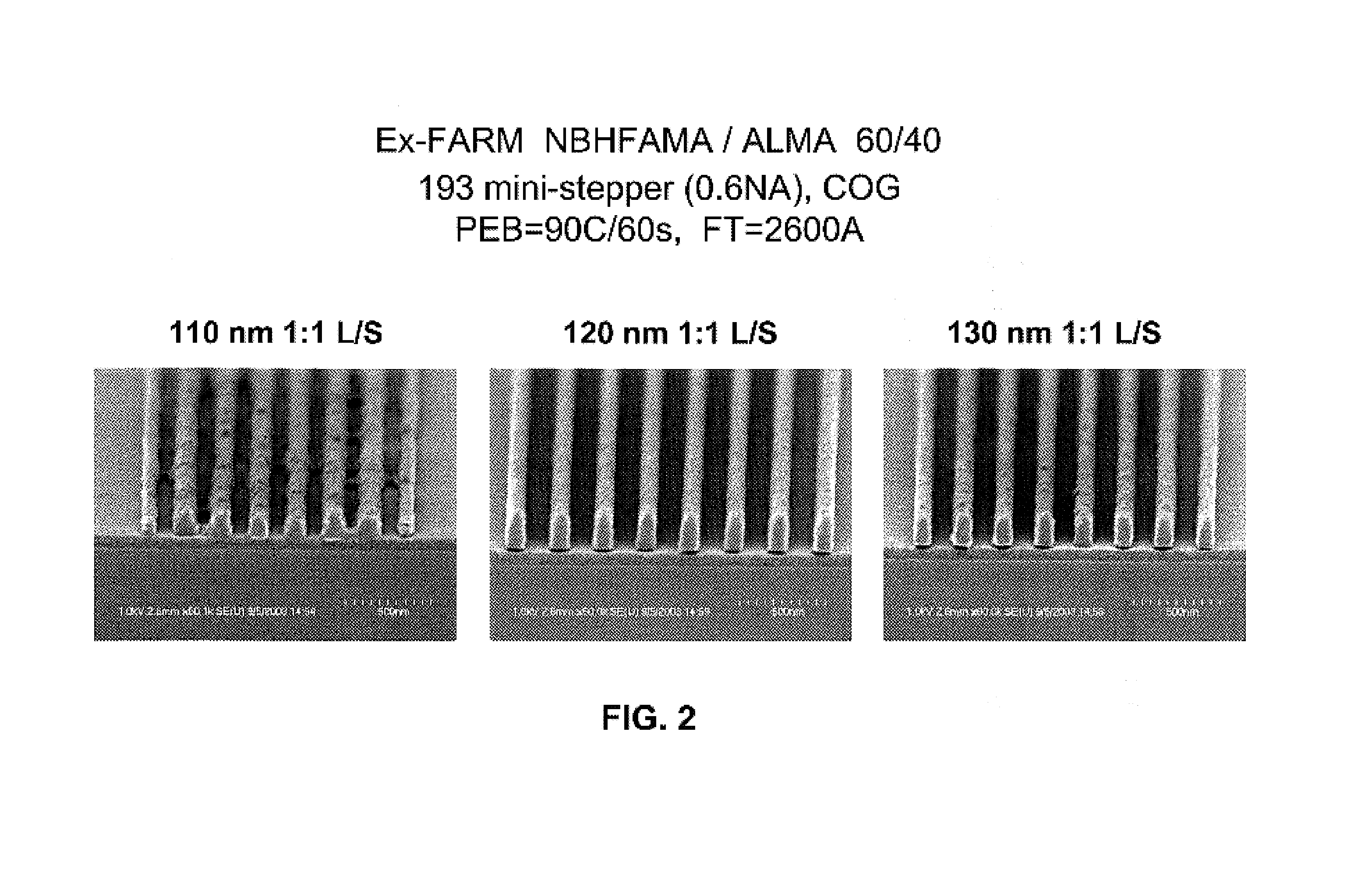Low activation energy photoresists
a low activation energy and photoresist technology, applied in the field of photolithography, can solve the problems of distortion in the developable image, certain barriers to achieving higher resolution and small feature size, etc., and achieve the effects of limiting the extent of acid diffusion, reducing the amount of activation energy, and minimizing certain disadvantageous conditions
- Summary
- Abstract
- Description
- Claims
- Application Information
AI Technical Summary
Benefits of technology
Problems solved by technology
Method used
Image
Examples
example 1
Synthesis of Ethoxymethyl methacrylate (EMMA)
[0171]To a 500-mL, 3-necked round bottomed flask equipped with a thermocouple temperature monitor, 250-mL addition funnel, nitrogen inlet and a magnetic stirrer was added 150 mL of dichloromethane, and 18.9 g (0.22 mol) of methacrylic acid. The addition funnel was charged with a mixture of 22.3 g (0.23 mol) of triethylamine and 25 mL of dichloromethane which was then added in a thin stream to the flask with stirring in an ice-bath. Upon completion of the addition, the addition funnel was recharged with a mixture of 18.9 g (0.2 mol) of chloromethyl ethyl ether and 25 mL of dichloromethane which was subsequently added dropwise to the reaction mixture with cooling over about 15 minutes. The ice bath was removed and the mixture stirred at room temperature overnight. The resulting suspension was filtered and the filtrate washed several times with saturated bicarbonate, water and brine and dried over anhydrous magnesium sulfate. Filtration and ...
example 2
Synthesis of 2-Ethoxy-2-ethyl methacrylate (EEMA)
[0172]To a 500-mL, 3-necked round bottomed flask equipped with a thermocouple temperature monitor, nitrogen inlet and a magnetic stirrer was added 300 mL of ethyl vinyl ether and 25.0 g (0.29 mol) of methacrylic acid. The mixture was cooled in an ice bath and 0.2 g (0.001 mol) of p-toluenesulfonic acid monohydrate was added. The flask was removed from the ice bath and stirred for 4 hours at which time the mixture was filtered through a bed of sodium carbonate and the ethyl vinyl ether removed on a rotary evaporator. The resulting oil was distilled twice from sodium carbonate at reduced pressure to yield 8.9 g (20%) of the title compound as a clear, colorless oil.
example 3
Synthesis of 2-Ethoxy-2-ethyl trifluoromethacrylate (EETFMA)
[0173]14.0 g of 2-trifluoromethylacrylic acid (2-TFMAA) and 30 g of ethyl vinyl ether were stirred at room temperature under nitrogen and using a DRY ICE condenser. The initial endotherm gave way to a mild exotherm to approximately 33° C. and some outgassing (reflux). The reaction was complete in 15 minutes. Et2O added. Organics were washed with 10% Na2CO3 (containing a small amount of NaOH), saturated NaHCO3 and finally brine followed by drying with MgSO4. Evaporated on rotary evaporator at 30° C. Yield 29.0 g of colorless liquid.
PUM
| Property | Measurement | Unit |
|---|---|---|
| wavelengths | aaaaa | aaaaa |
| wavelengths | aaaaa | aaaaa |
| wavelengths | aaaaa | aaaaa |
Abstract
Description
Claims
Application Information
 Login to View More
Login to View More - R&D
- Intellectual Property
- Life Sciences
- Materials
- Tech Scout
- Unparalleled Data Quality
- Higher Quality Content
- 60% Fewer Hallucinations
Browse by: Latest US Patents, China's latest patents, Technical Efficacy Thesaurus, Application Domain, Technology Topic, Popular Technical Reports.
© 2025 PatSnap. All rights reserved.Legal|Privacy policy|Modern Slavery Act Transparency Statement|Sitemap|About US| Contact US: help@patsnap.com



